Marketing meetings are a necessary evil. Necessary because they bring your team together and keep everyone focused on your goals. Evil because running meetings that don’t drain time and productivity is a challenge – and this is the problem we’re going to solve today.
Effective marketing meetings should boost the productivity of your team and improve your marketing processes. If you’ve ever sat there in a meeting, thinking that your time would be better spent elsewhere, this is the guide for you.
Today, we show you how to run effective marketing meetings that keep your team focused, enhance creativity and improve the results of your campaigns. We explore the dos and don’ts of effective meetings, the different types of marketing meetings you should be running and provide a template agenda that you can use to plan your meetings.
What are we looking at in this article?
In this article, we cover the good, bad and ugly of all things related to marketing meetings – so you can learn from the best and remove everything else. In fairness, marketing meetings are tricky and it took us years to find a process that works for us so we’re simply letting you learn from our own lessons, mistakes and breakthroughs.
Our process isn’t necessarily going to work for you but this article will help you find one that does. We’ve got seven key sections to cover in this guide and here’s a preview of everything we’re discussing today:
- Why marketing meetings are necessary: The benefits of effective marketing meetings.
- Why most marketing meetings suck: The tell-tale signs that your meetings need a rethink.
- Common types of marketing meetings: Know your daily scrums from your retrospectives.
- How to run effective marketing meetings: A 7-step process to running effective marketing meetings.
- Why every marketing meeting needs an agenda: An introduction to agendas and why you need one for every meeting.
- Agenda template: A marketing meeting agenda template you can use for every meeting.
- Stop meetings killing productivity: Best practices to stop meetings from getting in the way of progress.
You can jump ahead to each section by clicking on the blue link text above and you might want to bookmark this article for future reference. As we’re covering quite a lot of ground, let’s ease ourselves in by looking at the key benefits of effective marketing meetings and why they’re such a necessity.
Why marketing meetings are necessary
In this section, we’re discussing the necessities of marketing meetings but there’s a quick caveat to mention here. The benefits listed below are true of effective marketing meetings but they’re all compromised if you fall into the common traps that drag down the productivity of your meetings.
For now, though, let’s assume your meetings already rock.
They align everyone’s focus
The primary function of meetings is to keep everyone’s focus aligned on your marketing goals and objectives. For team members, individual workloads can direct their attention away from the real priorities – eg: a designer getting stuck in perfecting the next UI when the priority is getting a prototype that works by the end of the day.
Your meetings should keep everyone reminded of the purpose behind their actions, the goals they’re working towards and the targets they need to hit within specified timeframes.
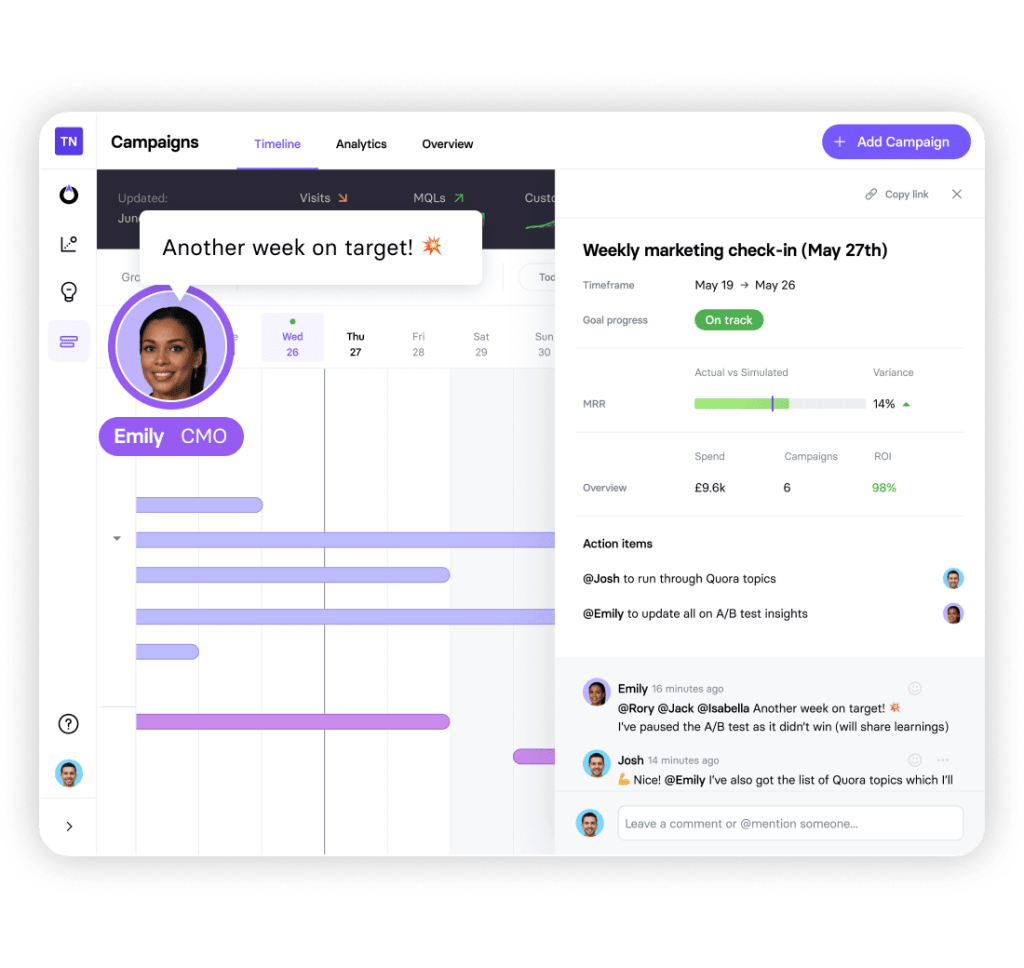
This is particularly important if you’re engaged in agile marketing that revolves around hitting targets quickly, typically using a process called marketing sprints. Sprints set short-term goals with deadlines of 5-14 days, meaning you need to hit targets every day, without fail – possibly multiple targets per day. In this case, you simply don’t have the time for team members to get distracted and your meetings need to keep everyone focused on the target.
They give everyone a voice
Marketing meetings also open a space where every team member has the opportunity to speak their minds, offer up ideas and raise any concerns they have. This should be encouraged because outside thinking can produce innovative solutions to problems, especially when team members have the chance to discuss and develop ideas.
Ideally, you want your meetings to be short and punchy but it’s always a good idea to include space for this type of discussion. In some meetings, you may simply ask if anyone has any suggestions or issues they would like to raise but, in other meetings (such as retrospectives), you’ll want to actively encourage members to discuss issues – eg: how can we avoid problem X in the next project.
They create a culture of ideas
If everyone attending your meetings has a voice, they also create a culture of ideas where individuals know their input has a positive impact. Human egos can make it difficult to develop a truly open culture of collaboration because the fear of being “wrong” is often so strong. There are plenty of cliches suggesting “there’s no such thing as a bad idea” but, honestly, the more important point is that “bad” ideas are simply part of the process of developing good ones.
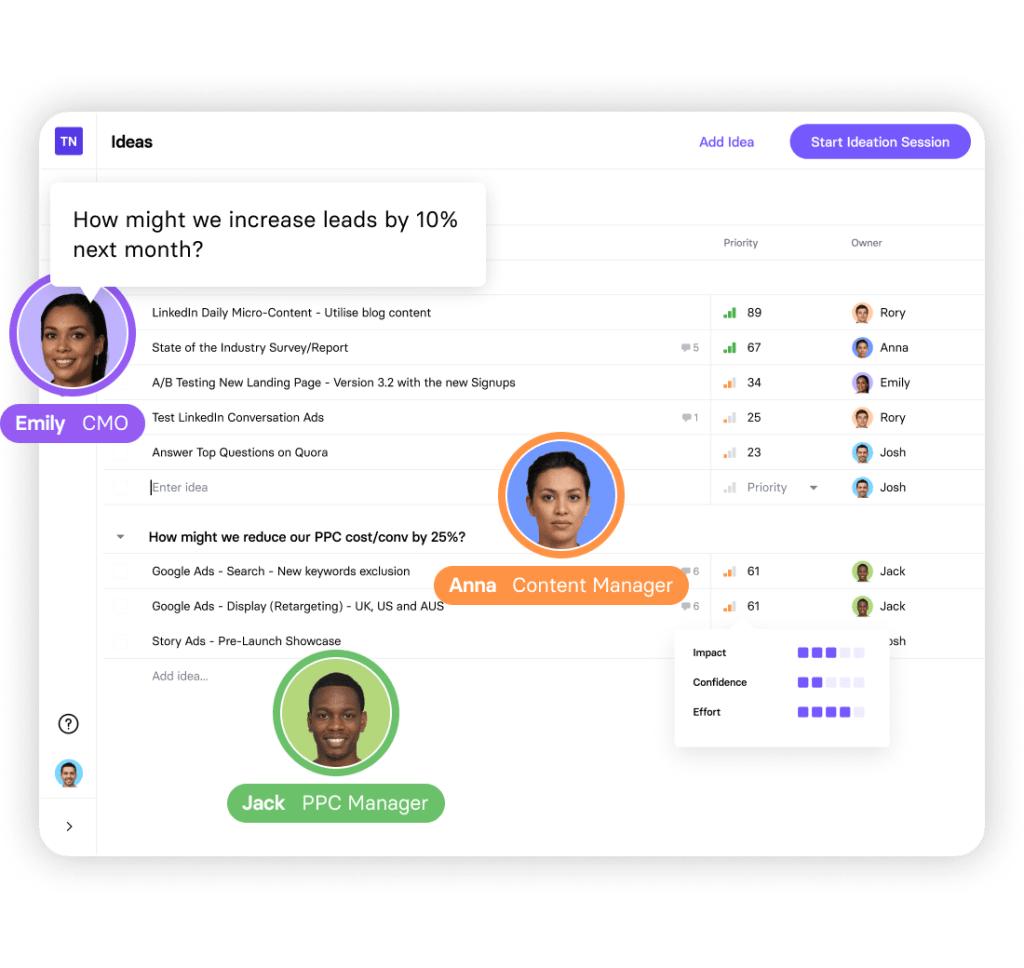
Bad ideas are valuable – that’s the key message – and nobody should feel ashamed or scared to come up with one.
A “bad” idea might be so unfeasible it beggars belief but this idea reinforces the reasons behind it being unfeasible. Other ideas might not be that bad but simply don’t work for the specific goal defined, the tools available or the team itself. Perhaps there are valuable questions to ask here: do we need the tools that could make this idea work or why isn’t this idea a good fit for our team?
Is the idea the problem or are we the problem?
In reality, no idea is 100% good or bad. Even the best ideas come with challenges, risks and other issues that need addressing. And every “bad” idea brings you one step closer to an idea that could work, probably by solving the same issues addressed while discussing why the previous few ideas won’t work.
To sum up, bad ideas are good. And, if you can nurture this kind of mentality in your marketing meetings, you’ve got yourself a culture of ideas capable of true innovation.
They build team spirit
The caveat definitely applies to this one because effective marketing meetings are great for building team spirit but ineffective ones are team spirit killers. You want people to leave your meetings feeling pumped, inspired and ready to make things happen. You want them to be glad they’re a part of this team and excited about celebrating the next big goal achievement.
As we’ll discuss later, celebrating success is a crucial part of running effective meetings. Your team deserves credit for all of the good they do and they deserve to feel confident about their abilities.
As a general rule, celebrate success and scrutinise failure – and the latter is for learning and improvement, not blaming anyone.
Make time in every meeting to discuss successes, no matter how small they may be. Show team members their work is appreciated and, most importantly, that quality and results are acknowledged. Otherwise, you end up with a team that feels like no matter what they achieve, it’ll never be enough – and that’s about as demoralising as it gets.
So work some positivity into the latter half of your meetings and end things by clarifying the day’s targets and hyping team members up for celebrating the next round of achievements.
They promote accountability
Marketing meetings promote accountability and this can be challenging when responsibility falls on an individual person. The word accountability itself can sound scary but you’ll dispel any of these negative connotations if you strike the right balance of scrutinising failures and celebrating success.
Again, scrutiny isn’t about blaming individuals (at least, it shouldn’t be) but about learning from mistakes and improving processes to avoid them in the future. Likewise, accountability isn’t about blaming anyone, it’s about fairly attributing outcomes to groups or individuals so they’re credited for their achievements and helped to improve any weaknesses.
At the analytical level, accountability shows you exactly what works, what doesn’t and where you need to improve – both individually and as a team.
Why most marketing meetings suck
Now that we’ve outlined the necessity and key benefits of effective marketing meetings, let’s discuss the most common characteristic of crappy meetings. If any of the following accurately describe your meetings, you need to rethink your process and you have to be brutally honest here.
Your meetings lack purpose
As with anything in this game, if you organise a meeting without purpose, you’re wasting everybody’s time. Just as every campaign should have a clear goal, you should know exactly what you wish to achieve by holding each meeting and take every possible step to make this goal achievable in a matter of minutes.
Don’t hold meetings for the sake of it. Organise meetings for specific reasons (we explain some of the most common types of meetings in the next section and only invite the people you need for that purpose. Don’t drag poor old Bill from accounts into your daily scrum unless you know he’s got good reason to be there.
Meetings with a clear purpose keep attendees focused and allow you to make fast progress.
Meetings are time-consuming
The biggest issue with marketing meetings is they’re time-consuming. You have to plan them, organise them and actually hold them – all of which takes time and resources away from core marketing tasks. This is why it’s so important that your meetings empower your team to achieve more. Your meetings have to be a worthwhile time investment by maximising the benefits listed above and minimising the negatives we’re discussing in this section.
Time is a precious commodity and this is especially true for marketing meetings. You need to make good use of time in the planning and execution of meetings. You want to end each meeting with a clear feeling that it was worthwhile and valuable – otherwise, you’ve only succeeded in wasting valuable time.
As we’ll explain in more detail later, meetings should be short and concise – not only to make effective use of time but to ensure participants are focused and engaged.
They interrupt other tasks
Organising tasks is another challenge and, unless you run them at the very start of the day (in an office environment where everyone starts at the same time), your meetings are going to interrupt other tasks. With meetings, you can’t please everyone and you have to schedule them in at a time that suits as many people as possible – that’s all part of the compromise.
The issue with interrupting tasks is that you get in the way of people’s workflows and fixed times leave no room for manoeuvre. Someone could be halfway through coding up a bug fix when they’ve got to jump into a meeting and, once the meeting is over, get back to the page of code, find where they were and complete the task – particularly difficult, if you’ve spent the last 30 minutes discussing something completely different in the meeting.
Interruptions range from mildly inconvenient to potentially quite damaging if mistakes are made.
You want processes in place to mitigate these risks and there are plenty of approaches you can take:
- Hold meetings at the start of the day if every team member starts their day at the same time.
- Arrange meetings for the same time to help team members arrange their schedule – eg: 9 am every Monday, Wednesday and Friday.
- Encourage team members to work on low-risk tasks ahead of meetings to ensure nothing crucial is interrupted.
- Be flexible with meeting times and schedule them around important tasks that should never be interrupted.
- Allow members to be late by 10 minutes if they need to wrap up something important.
Honestly, there are so many ways you can try to tackle this problem that you simply have to find what works for you. A lot of this depends on how your team operates – for example, office-based teams have the advantage of being able to hold meetings at the start of the day (assuming everyone starts at the same time) and avoid any interruptions at all.
It’s a little more complex if you have a remote team (partially or fully) where people may be working flexible hours or in different time zones. This is the case for us at Venture Harbour and we take a fairly flexible approach to meetings so people can finish important tasks.
The rest of us always have smaller tasks we can work on for 10 minutes if we’re waiting for someone who needs to finish something or get to a point where they can leave it for the meeting.
Most meetings are unproductive
Marketing meetings can easily drain time, personnel and other resources but they rarely produce high-value output that outweighs the input.
If you or your team members feel their time hasn’t been put to good use during marketing meetings, you’ve got a problem. When you’re interrupting people’s workflow and taking 10-30 minutes out of their working day, you need to make sure that your meetings produce enough value to justify the time spent.
You want every minute spent during meetings to add some kind of value and this can come in many forms:
- Motivation: Celebrating success, crediting individuals with work, reminding the team of previous achievements, etc.
- Critique: Analysing mistakes to understand why they happen and how to avoid them.
- Analysis: Reviewing campaigns/tasks to learn valuable lessons.
- Ideation: Discussing and developing ideas to turn concepts into workable strategies.
- Raising issues: Flagging up problems that need addressing.
- Problem-solving: Coming up with solutions for known issues.
- Plans: Actionable plans and steps to take once the meeting is over.
If your meetings aren’t producing some kind of value, you have to start questioning why you’re holding them in the first place. And, as we’ll explain later, one of the most common mistakes marketing managers make with meetings is holding too many of them.
Talk is cheap
Meetings are worthless if you spend 30 minutes making great plans that never come to fruition or take too long to implement. Make sure every meeting ends with a to-do list and have a process in place for tracking progress, such as task management software that you can add the following type of tasks to in meetings:
- Immediate tasks: Tasks individuals and teams need to complete as soon as the meeting is over.
- Short-term tasks: The items that should be completed on the day of the meeting or a fixed short-term deadline.
- Mid-term tasks: These should be completed by the end of the week or a specified deadline.
- Long-term tasks: Tasks that probably extend beyond the current campaign, which should be added to the backlog.
- Nice-to-dos: Tasks that would be beneficial to undertake if the opportunity presents itself.
Your meetings must produce actionable plans that improve the effectiveness of your marketing activities and these plans have to be put into action. Otherwise, you’re simply getting together to come up with ideas that’ll never see the light of day – a culture of speculation rather than innovation.
While we’re on this topic, take a look at our recommendations for the top to-do list apps and day planners to help you turn meetings into action.
Common types of marketing meetings
We’ve talked about the benefits and challenges of running marketing meetings and now seems like the right time to discuss some of the different types of meetings you’ll want to run. We could list all kinds of marketing meetings here – daily, weekly, monthly quarterly, etc. – but we’re going to focus on the more regular type of meetings that you would normally run at least once a month.
- Daily scrum / standup meetings
- Sprint review meetings
- Marketing plan reviews
- Campaign reviews
- Objectives review
- Goal progress review
- Marketing retrospectives
This isn’t an exhaustive list, by any means, but a short list of some of the most common types of meeting you’ll want to run on a regular basis.
Daily scrum / standup
Venture Harbour CEO, Marcus Taylor, gives us a good explanation of the daily scrum in his article, How to Implement Agile Marketing:
“The Daily Scrum or Daily Standup occurs at the beginning of each day during the sprint and lasts just 10 minutes or less. During these meetings, each Agile team member quickly recaps what they accomplished yesterday, what they’ll accomplish today and any roadblocks they’re facing.”
These meetings are designed to get team members quickly focused on the task at hand and give them a quick nudge in the right direction. They’re great for getting people into work mode and keeping your marketing goals at the centre of their minds every day.
Daily scrums are a classic characteristic of agile marketing but every team can benefit from holding these at the start of each day.
Sprint review
In agile marketing, a sprint is a short campaign (that typically runs for 5-14 days) with a clear, achievable goal. A sprint review is the meeting held at the end of one of these campaigns where the processes and results are discussed.
Marcus also defines the sprint review in his guide to agile marketing:
“The Sprint Review is a short meeting, less than an hour, which takes place shortly after the completion of the sprint. This meeting includes the Agile team, the Project Owner and the Requestor to hand over deliverables and discuss progress achieved. The Sprint Review is outcome-oriented, and there are no PowerPoint presentations allowed!”
These meetings are crucial for analysing your sprint marketing process, identifying problems and finding new solutions that help you achieve ambitious goals in a short time frame.
Marketing plan review
Marketing plan reviews are typically run once a month to discuss the progress of broad marketing plans. Within this marketing plan are the individual campaigns and strategies with their specific goals – so you’re reviewing these collectively within the context of your broader marketing goals, which typically include financial KPIs and long-term objectives.
Campaign review
As the name suggests, campaign reviews analyse the progress of individual marketing campaigns and the frequency of these meetings depends on the duration of your campaigns. For example, if you’re running a sprint campaign, this role is already filled by the sprint review so you’re not going to need another campaign review. However, longer campaigns will require periodic review meetings, especially ongoing campaigns that run for several months.
Objectives review
Objectives are the milestones that make up your marketing goals and we’ve explained the difference between goals vs objectives in our ultimate guide to marketing strategy:
- A marketing goal is a broad, long-term result you want to achieve, such as increasing revenue, reducing customer churn, increasing engagement by 40%, etc.
- A marketing objective defines the specific, measurable actions marketers must complete to achieve specific goals. For example, if your goal is to reduce customer churn, one objective might be to increase email open rates by 30+%.
So, objective review meetings discuss the completion of your marketing objectives to ensure you’re on track to fulfil your marketing goals. This is especially important for long-running campaigns where it’s easy to lose track of the primary goal and missed objectives can hinder your chances of achieving them.
Goal progress review
Goal progress reviews are pretty self-descriptive: meetings that discuss the progress of goal completions. Again, these are particularly important for long-running campaigns where regular reviews can help you stay on track to achieving your goals.
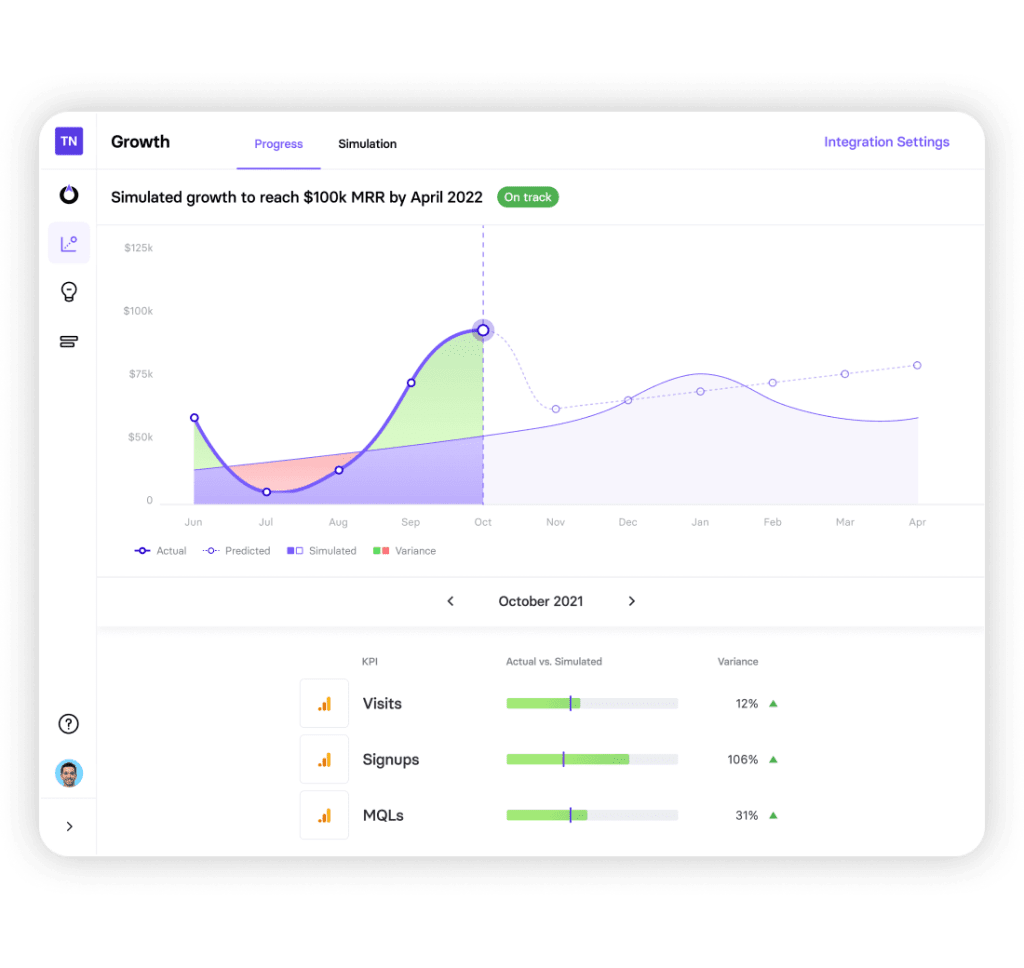
These meetings may include an objectives review but the priority is to analyse your marketing processes and actions to ensure your goals remain achievable and on target.
Marketing retrospectives
Marketing retrospectives are reviews that analyse every marketing process after the completion of a campaign or marketing goal. At the end of a sprint run, you’ll run a sprint review and, later, you’ll run a sprint retrospective – so what’s the difference between the two?
- Sprint review: Focus is on the product and success of the campaign in achieving the goal.
- Sprint retrospective: Focus is on the team and the marketing processes.
Generally speaking, the sprint review will include senior marketers and stakeholders while the retrospective will include marketing managers and the marketing team involved. In truth, these are all semantics, as long as you understand the value of analysing the campaigns and the process.
How to run effective marketing meetings
In this section, we explain how to run effective marketing meetings in seven key steps:
- Set an agenda for every meeting
- Keep meetings short
- Keep meetings focused
- Only invite the people you need
- Produce actionable takeaways from every meeting
- Celebrate success
- Run fewer meetings
We’ve touched on most of these points already but this is the first time we’re introducing the idea of meeting agendas, which will feature heavily throughout the remainder of this article.
Step #1: Set an agenda for every meeting
The most important asset for effective marketing meetings is a detailed agenda. To maximise the benefits we’ve discussed in this article and overcome the challenges of running productive meetings, you should set an agenda that outlines the goals, topics, and personnel for every meeting.
We’re going to explore the topic of meeting agendas in far more detail during the second half of this article but the key point at this stage is to create an agenda for every meeting and send them out to attendees early.
An agenda keeps meetings focused and on track while helping attendees prepare everything they need to go into the meeting and add value from the moment they sit down. By providing clear instructions, you can guide the discussion and ensure your get-togethers fulfil their objective and produce actionable insights.
Later on in this article, we explain why every marketing meeting needs an agenda (in more detail) and we’ve also got a template you can use to easily create your own agendas.
Step #2: Keep meetings short
Some marketing meetings are short by nature (eg: daily scrums) but you should strive to keep every meeting as short as possible. Numerous studies over the years have found that shorter meetings are more productive and, as you’ll see from this visual produced by CoSchedule, 15-minute meetings are often the sweet spot.
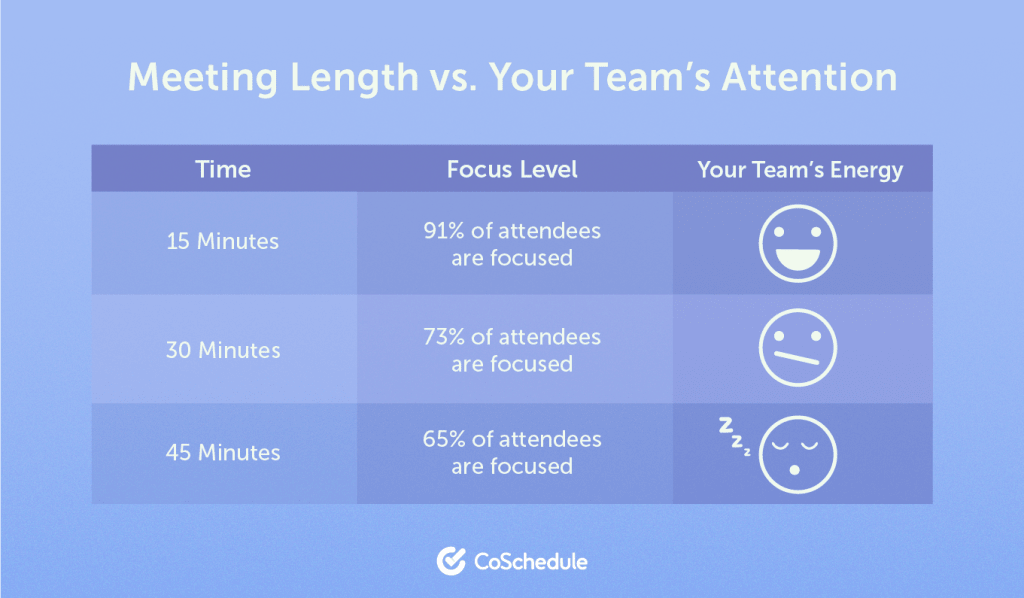
During the first 15 minutes of a meeting, 91% of attendees remain focused but this figure drops to 73% after 30 minutes and 65% by the 45-minute mark. Focus isn’t the only issue with longer meetings, either. Retention is another concern, as people are only capable of remembering a finite amount of information – so concentrate on the key points that really matter.
This ties in with the next point of keeping meetings highly focused (topically) and the following step of only inviting the people you really need. Smaller meetings with topically focused agendas are naturally shorter and more engaging.
Step #3: Keep meetings focused
We talked about focus in the previous section in the sense of keeping the minds of your team focused during meetings. However, at this point, we’re talking about the topical focus on your meetings, in terms of keeping the discussion relevant to the agenda and avoiding any distractions or wanderings off-topic.
Once again, your agenda is the key asset here and you should outline the specific topics to cover in your meeting. By sending out agendas to attendees early, they know which topics are open for discussion and you should make it clear that nothing outside of the agenda is up for discussion during the meeting.
Step #4: Only invite the people you need
You may remember, earlier, we talked about poor old Bill from accounting getting called into marketing meetings when he’s got a stack of outstanding invoices to chase up. Clearly, there’s no reason for Bill to attend marketing meetings but, sometimes, it helps to exaggerate when illustrating a point. And, in many cases, it’s not always so clear cut who should attend specific meetings and who shouldn’t.
It gets more difficult to make the call when you’re reviewing a conversion optimisation campaign and you have to decide whether the designers and developers involved should be present in the retrospective meeting. There’s no right or wrong answer here, either. In fact, it really depends on how the campaign worked out and the extent to which design and development processes affected the marketing outcomes.
The list of suitable attendees varies from one meeting to the next but you should always strive to only invite the people you really need.
Step #5: Produce actionable takeaways from every meeting
We touched on this point earlier when we said every meeting should produce actionable next steps for the team and individual members. We listed five different types of tasks that your meetings should determine:
- Immediate tasks: Tasks individuals and teams need to complete as soon as the meeting is over.
- Short-term tasks: The items that should be completed on the day of the meeting or a fixed short-term deadline.
- Mid-term tasks: These should be completed by the end of the week or a specified deadline.
- Long-term tasks: Tasks that probably extend beyond the current campaign, which should be added to the backlog.
- Nice-to-dos: Tasks that would be beneficial to undertake if the opportunity presents itself.
You don’t necessarily need to include all five types of these tasks on your meeting notes but you should, at the very least, have the trio of immediate, short-term and long-term tasks that you’ve decided upon during your meeting.
You’ll need to leave space in meetings to discuss these steps and have a system in place to create these as tasks in organised to-do lists. Ideally, team members should attend meetings without their phones or other devices (if they’re attending in-person) and any remote participants should remain focused on the meeting itself.
So the person holding the meeting should be in charge of adding tasks to lists, which allows attendees to remain focused on the discussion without constantly jotting down notes.
Step #6: Celebrate success
We also touched on this earlier as a technique for building team spirit and motivating team members to keep hitting targets. By celebrating success, you create a psychological reward system that perpetuates a continued desire to keep getting results. And, beyond the psychology of reward signals, recognising the achievements of your team and team members shows their efforts are appreciated.
The opposite of this would be a team that never celebrates success and you have to wonder how long team members will give everything 100% before they get the sense that it doesn’t matter how hard they try because their effort is never acknowledged, let alone rewarded.
Celebrating success also creates a culture of merit – or a meritocracy – where results are rewarded and individuals are incentivised to achieve results. You don’t need to reward team members with cash prizes or company stocks, either. recognition for hard work, feeling good about achievements and feeling like an important part of the team is often reward enough – and you can give team members all of this by celebrating their successes.
Another important role this plays is helping you to hold individuals accountable and scrutinising things that don’t go to plan. By celebrating successes, you can offset any discontent people might experience by having their actions criticised. As long as individuals know there’s nothing personal about the scrutiny and their successes get as much positive attention as their underachievements are being analysed, the meritocracy sustains itself.
You can nurture this culture further by reminding people that accountability and analysis are only designed to improve results for everyone, that every mistake is an opportunity to learn and the next marketing action is another opportunity to celebrate success.
Step #7: Run fewer meetings
If your marketing meetings aren’t as productive as they could be, the fastest way to improve them is often simply holding fewer meetings. Try running fewer meetings and make the remaining ones as short as possible. Don’t hold meetings for the sake of it and constantly review your meeting schedules and structures to see where you can trim some unnecessary fat.
Always keep an open mind to alternatives to holding meetings to sticking to the traditional formats, too.
For example, we use a platform called TrueNorth to manage our marketing strategies and one of its key features is meeting-less ideation. The platform allows team members to quickly add campaign ideas whenever they come up with something and invite colleagues to get involved at a time that works for them. This helps ideas develop organically before you even get into meetings so you’ve already got something to work with when you all sit down together.
You can still hold group ideation sessions but you’re not starting from zero and putting attendees in the spot to come up with great ideas under pressure.
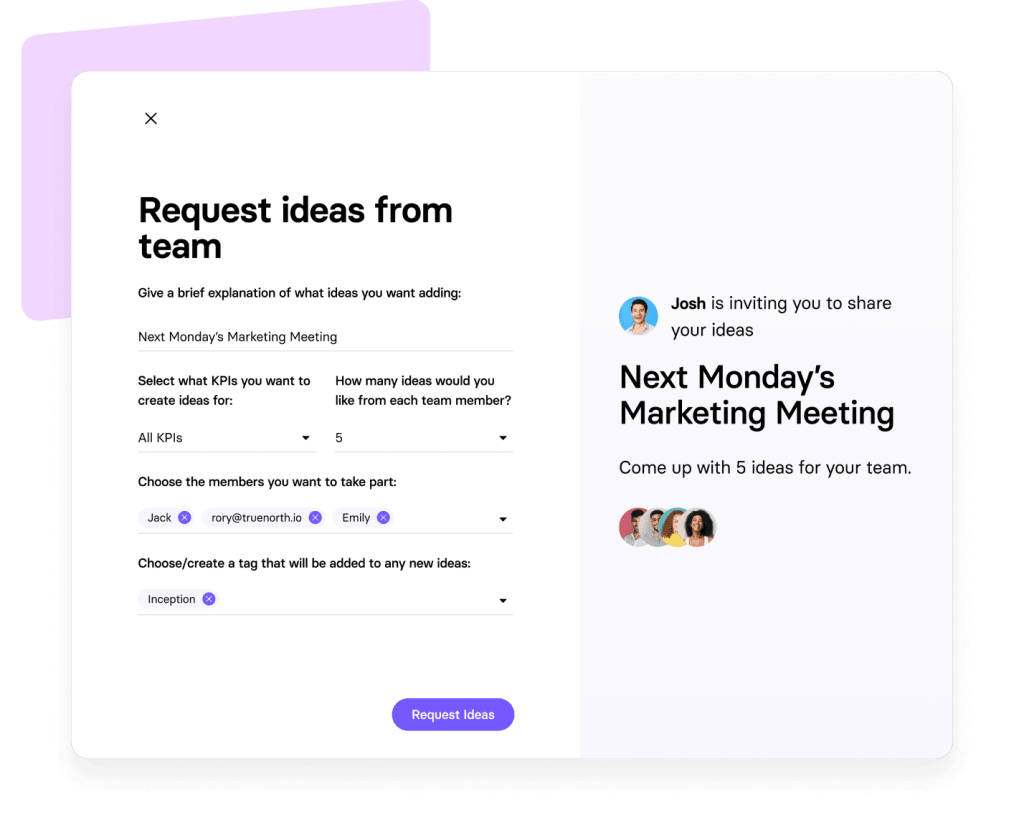
Team managers can also request ideas ahead of meetings with a few clicks, giving them time to think about potential ideas and collaborate with anyone they need to, ahead of the meeting. In many cases, we’ve got enough ideas to work with before meetings even start and we’re ready to jump right into developing and maturing ideas, prioritising them and simulating campaign ideas to see which briefs are most likely to succeed.
This reduces the number of meetings we need to hold and the time we have to spend in meetings but, more importantly, our meetings are more productive and we’re coming up with better ideas – and we’re able to turn ideas into real campaigns much faster.
The result: Less time meeting, more time doing.
Why every marketing meeting needs an agenda
Every marketing meeting you run should have an agenda outlining the discussions and activities expected to take place. This is the template that keeps your meetings focused, time-efficient and productive. Without an agenda, your meetings lack structure and clear objectives, which means you’re inevitably wasting time and, possibly, achieving nothing at all when you call your team together.
Here are the key benefits of creating an agenda for every meeting, which we’ll explain in more detail shortly:
- Every meeting has a goal to achieve – one that adds value to your marketing activities.
- Everyone knows what to discuss so the conversation remains relevant to achieving said goal.
- You can keep the conversation focused by only discussing topics specified in the agenda (or relevant to them).
- You know who to invite to your meetings so nobody’s time is wasted.
- Everyone has time to prepare for meetings and add something of value.
Ultimately, your agendas ensure meetings contribute value to your marketing processes and your time spent discussing important topics is well spent.
Reason #1: Every meeting has a goal
Every meeting you run should have a clear purpose to ensure they’re producing more value than the time invested into them (and taken away from other activities). For example, if you’re running a retrospective meeting for a campaign that’s just ended, your goal might be to discuss the challenges faced during the campaign and how to avoid them or overcome them more effectively next time.
Having this clear goal allows you to create an agenda that works towards fulfilling it and you might decide to dedicate more time to discussing issues experienced during the campaign than analysing results – particularly if the results are already known or not informing your team’s immediate workload.
At the end of every meeting, you should have a list of clear takeaways or next steps that contribute to future marketing actions.
Reason #2: Everyone knows what to discuss
The primary role of a meeting agenda is to outline the topics of discussion and all of the key points that have to be covered. For example, if you’re running a campaign review meeting to discuss the first few months of progress, you might set the following talking points in your agenda:
- Review metrics and KPIs
- Analyse performance for the past three months
- Project performance for the next three months
- Discuss objectives (achieved, unachieved, pending)
- Discuss issues experienced (solved, unresolved, pending)
- Review goals and objectives – have they changed?
- Discuss ideas and concerns not yet raised
- Next steps
You can add notes to each section in your agenda to guide the conversation. For example, in section one, you might list the metrics and KPIs you want to discuss and you can list the key performance takeaways to discuss in section two. There’s always space for team members to add to the conversation but you can ensure the key topics are covered and maintain relevance throughout the meeting.
Reason #3: You can keep the conversation focused
By specifying the goal of every meeting and outlying the structure in your agenda, you can keep the conversation focused on achieving that outcome. By creating a culture of goal-oriented meetings within your team, you can avoid discussion veering off-topic or individuals trying to direct talks towards their own interests – something many people have a natural (and, often, unconscious) habit of doing.
For example, if you’re holding a meeting to discuss the launch of a campaign later in the day, this probably isn’t the time for people to chime in with requests for a new software tool or suggest a new routine for lunch breaks.
You have to strike that balance of creating an environment where people can always offer ideas and raise concerns, as long as they’re relevant to the current meeting. This might be tricky, but you can emphasise the point that time is precious and unproductive meetings are detrimental to everyone, making it important to stick to the topics outlined in the agenda.
As long as you make it clear to individuals they can always approach you outside of meetings with issues of any nature, it’s fair to expect that your agendas are respected.
Reason #4: You know who needs to be there
Without specifying clear goals and the topics/activities being covered in your meetings, it’s difficult to know who really needs to be there. Meetings are already a drain on resources and the last thing you need is to take people away from work they could be doing when they don’t even need to be in a meeting.
They’re not going to add any value to the meeting and they’re probably not going to appreciate being there, either – especially when they could be doing something of value elsewhere.
Reason #5: Agendas give attendees time to prepare
By creating agendas for every meeting and sending them out to everyone invited, you give attendees time to prepare. In the same way you don’t want to invite team members who don’t need to be present in meetings, you want everyone who does attend to add some kind of value to the meeting.
It’s not always easy to do this on the spot, especially if people are only seeing the meeting agenda for the first time as they sit down at the table.
Create your agendas early and send them out to attendees in plenty of time so they can prepare for your meetings and raise any suggested topics of discussion they feel should be added to the agenda. You’ll find everyone has more to contribute in meetings and it’s easier to keep the conversation focused on the target outcome.
Marketing meeting agenda template
To help you create meeting agendas faster, we’ve come up with a simple template you can use and edit. Keep in mind, you’ll want to create slightly different agendas for different types of meetings so we’re including the most common sections normally expected in a meeting agenda. You don’t necessarily need to fill out every section for every meeting and you would need to add some for certain types of meetings, too.
We can’t include everything in one template so, for the sake of simplicity, we’re sticking to the following 11 sections in this agenda template:
- Meeting name/type
- Meeting goal
- Metrics & KPIs review
- Performance analysis
- Achievements
- Challenges
- Goals & objectives review
- Budget review
- Ideas & issues
- Takeaways
- Next steps
You don’t need to complete every section – for example, if there’s no need to review the budget for a campaign in the next meeting, simply leave this section blank or delete it.
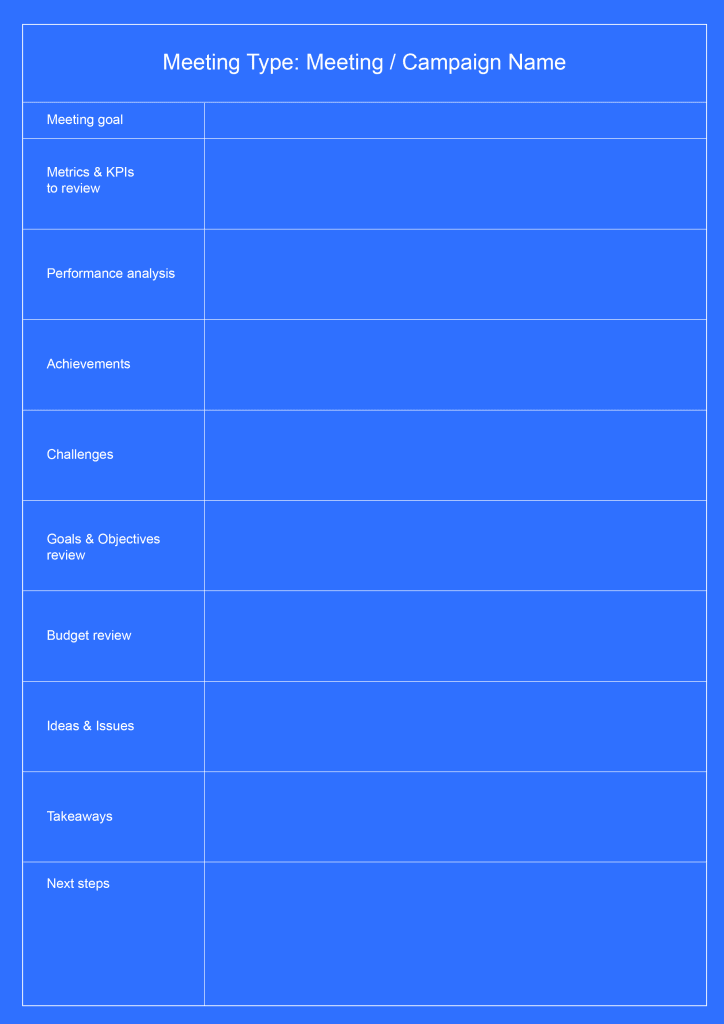
As you’ll see in our template, there’s a box to include the time available for each section in the meeting itself. This will help you keep meetings short, even if you allow some extra time for running over on a section or two. To hit your time targets, attendees will need to enter the meeting with clear ideas and points to raise, which is why it’s so important that you send out agendas early, giving everyone time to prepare.
Step #1: Name your meeting
The first step to creating your marketing agenda is to name the meeting and all you really need to do here is specify which type of meeting you’re holding. For example, if you’re running a campaign review, you can simply name your meeting as Campaign Review: [Campaign Name] so it’s clear what the purpose of the meeting is and the exact campaign you’ll be discussing.
Step #2: Define the goal(s) of your meeting
Every meeting should have a desired outcome (improve processes, resolve technical issues, reduce turnaround times, diagnose goal incompletions, etc.) and your team members need to know what this is. Specify the goal of your meeting at the top of your agenda and use this to guide the topics of conversation and activities set for your meeting.
If you have multiple goals, it’s fine to list more than one but be wary of meetings becoming too complex or time-consuming.
Step #3: List metrics & KPIs to discuss
If you’re going to discuss campaign performance in your meeting, list the metrics and KPIs you want to focus on so everyone attending the meeting understands which data points the conversation will revolve around. In the meeting itself, you may also want to review the quality of your analytics and the relevance of the metrics and KPIs you’re monitoring.
Again, be conscious of how many metrics you plan to talk about and the time you want to dedicate to this part of the meeting.
Step #4: Outline performance analysis
This is where you discuss the historical performance of your campaign with a key focus on the objectives achieved so far and the progress towards completing goals (or a review if the campaign has ended). Essentially, you want to make sure your campaign is hitting targets and remains on track to achieve your goals once the campaign comes to an end.
Step #5: List your achievements
In any kind of progress review or retrospective meetings, you want to discuss the achievements of your team and individual team members (we discussed this at length earlier). Celebrate successes and confirm what is being done correctly by quickly running through the achievements of your campaign so far.
Step #6: List known challenges
This is where you want to discuss any unresolved challenges that could impact the future performance of your campaign or marketing processes. At this stage, you can only list the known challenges you’re already aware of but give attendees the opportunity to add challenges to this section ahead of your meeting and raise any others they think of during the meeting.
Step #7: List any goals or objectives that need revising
As your campaigns run, you’ll often find certain goals and objectives are either too unambitious or unachievable. If your campaigns are overachieving or your goals are looking difficult to achieve, you may need to revise them. In most cases, this is a conversation reserved for meetings with shareholders and senior marketers but, in some instances, you may need to have this conversation with marketing teams to come up with ideas for what can/can’t be done.
In any case, if the targets for a campaign are changing, you need to inform your team – and this is the place to do it.
Step #8: Budget review
The same thing applies to budgets and you’ll often find spend needs reallocating to get the best return on your marketing investment. Generally speaking, you want to invest more in high-performing campaigns/channels and reduce spend on underperformers. This affects the day-to-day work of people involved in these campaigns and, once again, they need to be informed.
Much like goal and objective reviews, the decision-making typically happens at the board and senior marketing level.
Step #9: Raise ideas & issues
This is the space to include any ideas or new issues that need raising in the upcoming meeting and, even if you don’t have anything to add yourself, this is a great section to leave blank for team members to add suggestions ahead of the meeting. Also, include some time during the meeting for team members to raise ideas and any issues not already discussed.
Step #10: Fill in the key takeaways (during the meeting)
With the meeting coming to an end, you should discuss the key takeaways with team members and add these to the agenda and/or meeting notes. Everybody should have a clear mind on the most important points raised in the meeting and what this means for the next round of marketing activities.
Step #11: Define the next steps (during the meeting)
LEading on from the previous point, the final step of your meeting is to define the next steps for your team and individuals to conduct once the meeting is over. As we mentioned earlier, you should include immediate, short-term, medium-term and long-term next steps where relevant (you don’t necessarily need all of these for every meeting but people need to understand the prioritisation of tasks).
How to stop meetings killing your productivity
By following our seven-step process for running effective marketing meetings and using our agenda template, you’ll get greater value from every meeting. Now, let’s run through some final best practices to prevent any bad habits from sneaking into your meetings and killing your productivity.
Don’t run meetings for the sake of it
The final point in our seven-step process is to run fewer meetings and the aim here is to reduce quantity while increasing the quality of output. The key thing to avoid is running meetings for the sake of it and, hopefully, you can avoid this at the agenda stage when it comes to setting a goal for your meeting.
If you’re struggling to set a goal (ie: a valuable outcome), you should question whether this meeting needs to be held at all.
When you’re filling out your meeting agenda, be critical of everything you include. What’s the value in discussing a bunch of metrics retrospectively – are you going to learn something from this or are you simply going to sit there describing historical performance and occasionally nodding heads?
Take the brainstorming & ideas out of meetings
On the same topic of running fewer meetings, we also touched on how we use TrueNorth to come up with campaign ideas and test outcomes without holding meetings. It’s not only a question of holding fewer meetings but also taking out the time-consuming elements of marketing meetings.
For us, this tends to be brainstorming and ideation where people are forced to think and come up with fresh ideas on the spot.
In our experience, this takes up way too much time and also produces weaker ideas than the ones our team members come up with while they’re working on something or having a natural conversation with team members outside of a meeting. So we’ve almost eliminated brainstorming from our meetings entirely – along with all of those awkward pauses where people try to come up with ideas on the stop or rehash old ones we’ve already tried.
This allows us to run fewer meetings and significantly reduces the time we spend in meetings. We can still hold brainstorming sessions if we need to but we’re no longer reliant on this as a tool for coming up with ideas. Instead, our team can add ideas to TrueNorth, at any time, and invite people to collaborate with and develop them. There’s no pressure for every idea to sound promising and we use TrueNorth’s campaign simulator to forecast outcomes.
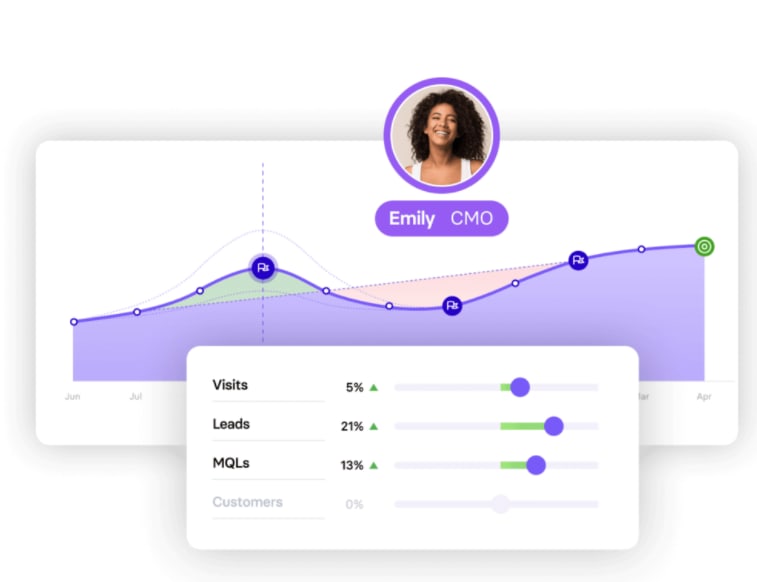
This way, we’re choosing campaign ideas based on data outcomes and our team members can feel confident about their suggestions when they’re raised in meetings because the data is backing them up. Aside from making our meetings shorter (and more productive), this system helps us develop campaign ideas faster and prioritise our marketing action based on predicted outcomes.
The data we get from campaign simulations also helps us decide when we need to hold meetings. As mentioned earlier, it’s quite common for campaigns to either over or underperform and you have to react to this by reassessing your goals, adjusting your marketing spend or optimising campaigns to improve results.
With TrueNorth’s campaign simulator, we can see where marketing performance veers off the predicted path sooner and take action at the earliest opportunity.
Automate what you can
There are plenty of tools that will help you automate time-consuming aspects of meeting management. For example, Calendly helps you automate meetings schedules by showing team members’ availability so you can set meeting times to suit everyone without any email exchanges. This is particularly helpful if you’re running remote meetings and flexible working where it’s not possible to hold regular meetings, in the office at set times.
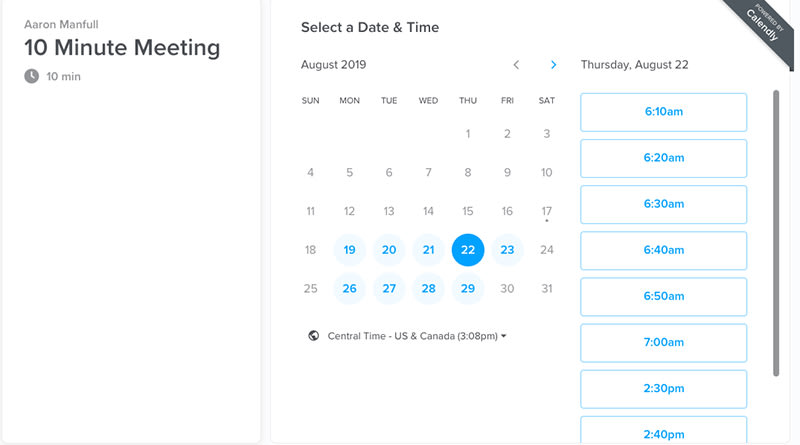
nTask is another great tool for managing meetings, one that also helps you with the meeting notes and organising the next steps we discussed earlier. As we said, every meeting should produce key takeaways and/or next steps to take, which may include some or all of the following:
- Immediate tasks: Tasks individuals and teams need to complete as soon as the meeting is over.
- Short-term tasks: The items that should be completed on the day of the meeting or a fixed short-term deadline.
- Mid-term tasks: These should be completed by the end of the week or a specified deadline.
- Long-term tasks: Tasks that probably extend beyond the current campaign, which should be added to the backlog.
- Nice-to-dos: Tasks that would be beneficial to undertake if the opportunity presents itself.
With nTask, you can easily create meeting minutes to include all of the key takeaways and add text steps to team or individual to-do lists, tasks or projects.
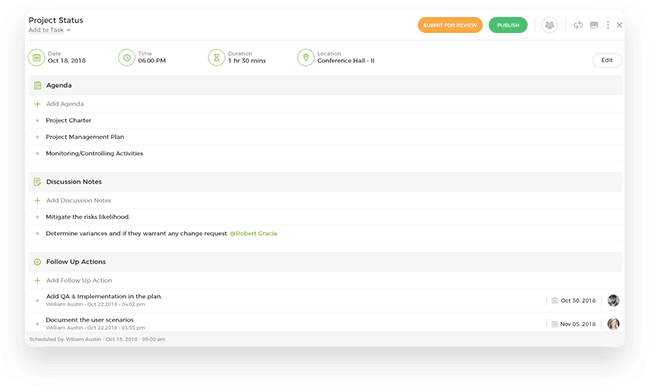
You’ll find plenty of other automation tools that can help improve your meeting and other business processes in this article, 10 To-Do List Apps & Day Planners to Get More Done.
One small word of warning on meetings app and automation, in general. Technology is great but technical problems are a nightmare in meetings so make sure you choose tools you can rely on when you need them – especially if you’re running meetings remotely. Another thing to keep in mind is that automation tools should generally step back and manage tasks in the background so you can get things done faster.
You don’t want to waste time fiddling with UIs, constantly changing settings or manually completing unnecessary tasks (either in or out of meetings).
Let the data guide decisions
The conversational nature of meetings means opinions, feelings and bias can easily creep in, even if you think you’re taking steps to keep everything objective. The only way to achieve and maintain objectivity is to let the data do the talking and guide your decisions.
When you’re creating your agenda for the next meeting, you should set a clear goal/target outcome and you’ll achieve this much faster if you let data steer the conversation. Earlier, we explained how TrueNorth’s campaign simulator provides the data we need to choose and prioritise campaign ideas and this removes any ego from our decision-making.
We’re constantly surprised by the outcomes and how ideas that seem great don’t always pan out. Likewise, the top-performing campaigns often come from ideas that seem less remarkable during the early planning stages – and this is just how marketing works. It’s a results-driven practice and the results don’t care how impressive ideas seem when they’re first raised.
As long as everyone in your team realises this, you remove the ego we naturally attach to our own ideas but you also remove the fear of suggesting ideas that don’t seem great at the time. This develops a more open, creative environment and it also keeps your meetings focused on the one thing that matters: outcomes.
Stick to the agenda
Finally, make sure you stick to the agenda in every meeting to avoid any irrelevant discussions and running over time. If team members raise anything that’s not relevant to the meeting, tell them they can discuss this with you after the meeting and get the conversation back on track right away. Your team members must know they can approach you with anything and raise any (relevant) points during a meeting but also understand that relevance is important and anything else can be discussed once the meeting comes to an end.
If there’s any room for flexibility in your agenda it should only be the amount of time you dedicated to certain sections. With careful planning, you should be able to move on to the next section within the time frame you’ve set but there are always instances where discussions may take a little longer.
You’ll probably find this happens most often when you’re discussing challenges that haven’t been resolved. These are the most important discussions in your meeting so you don’t want to get in the way of any potential resolutions. At this point, you have to decide whether to let the conversation carry on or make time to discuss this specific issue in more detail once the meeting ends.
Get more from your marketing meetings
The aim of this guide is to help you make your meetings more productive so you and your team can spend less time in the conference rooms (physical or virtual) and more time getting results. Effective marketing teams put plans into action quickly, which requires an agile creative environment and processes that enable you to deploy new campaigns without any unnecessary delays.
By making your meetings more productive and improving the collaborative workflow of your team, you can streamline planning to develop and implement ideas faster. In this article, we’ve given you a template to plan more effective meetings and also explained how your team can develop and test campaign ideas outside of the meeting room.
Create your agenda for every meeting, send them out early so everyone has time to prepare (and possibly contribute to the plan) and stick to the agenda throughout the meeting without veering off-topic at any point. Only hold meetings when you need to, keep them as short as you can to achieve the goal defined in your agenda and direct anything irrelevant to the discussion for talks outside of the meetings.
If you’ve got any other issues with marketing meetings that we didn’t raise in this article or suggestions that might be helpful, we’d love to hear from you.




